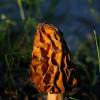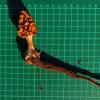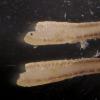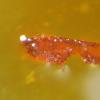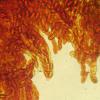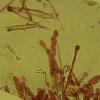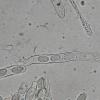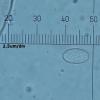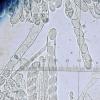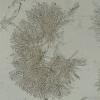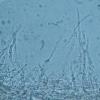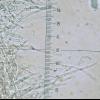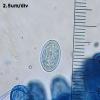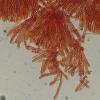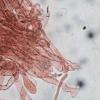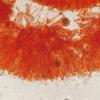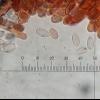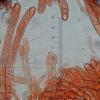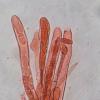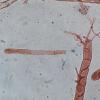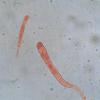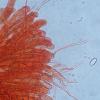
24-12-2025 17:08
Hulda Caroline HolteHello, I have found this propoloid ascomycete on

21-12-2025 09:32
Hello.A tiny ascomycete found embedded in wood in

21-12-2025 21:32
Pol DebaenstHello, Garden, Burgweg 19, Veurne, BelgiumOn 10/1

22-12-2025 23:38
Patrice TANCHAUDBonsoir, récolte sur un mur en pierre, apothéci

22-12-2025 00:47
Patrice TANCHAUDBonsoir, récolte à proximité du milieu dunaire
 I have found a Morchella which is extremely rare in my country (only 2 reports). It was growing in a weedy area attached to what I think a root. It had a brownish-mustard yellow colour with wide alveoli made by rather thin walls. I tried to find some literature, ideally a key but I was not successful. The literature on ascofrance provides a monograph, but based on phylogenetics. I have collected the specimen but I have not carried any microscopical tests yet.
I have found a Morchella which is extremely rare in my country (only 2 reports). It was growing in a weedy area attached to what I think a root. It had a brownish-mustard yellow colour with wide alveoli made by rather thin walls. I tried to find some literature, ideally a key but I was not successful. The literature on ascofrance provides a monograph, but based on phylogenetics. I have collected the specimen but I have not carried any microscopical tests yet. I don't really know what/how to examine Morchella and what charachters are determinant. Any help / keys would be essential for me.

Paraphyses: Present, not frequent, septate, shorter from asci
Paraphyses shape (apex): Capitate, with a rounded, elliptic-rectangular or rarely irregaular-deltate head, (24.1-)30.7(-34.1) µm long
Paraphyses width: Column 6.8-9.5µm (mean 8.37µm) ; apical head (widest part): 12-17.8µm (mean 14.1µm)
Paraphyses length: Total length 142-174µm (mean = 161.4µm); Length of apical hypha 98-129µm (mean = 113.4µm)
Other remarks: Paraphyses dextrinoid in IKI, especially its head. They are 1- to 2- (3- septate), with the septa located at the basal third of the paraphyses.
Ascum
Shape: Cylindrical, straight or slightly sinusoidial-irregular, usually with a distinct kink at the base
No. of Spores: 8
Operculum Not: observed
Tunic (Wall): Uni-tunicate
Ascum length (range): 220 - 288 µm
Ascum length (mean): 262.7 µm
Ascum width (range): 15.2 - 20.8 µm
Ascum width (mean): 17.7 µm
Ascum L:W ratio: 15
Iodine reaction (J +/J -): J-ve but dextrinoid
Orifice: Absent
Remarks: Sometimes spore are clustered at the top of the ascum making it to swell nad bulge
Spore
Spore length (range): 20.26 - 24.9 µm
Spore length (mean): 22.7 µm
Spore width (range): 9.97 - 15.9 µm
Spore width (mean): 12.4 µm
Spore Q factor (range): 1.54 - 2.24 µm
Spore Q factor (mean): 1.84
Spore shape: Fusoid-elliptical, widest at the centre with two identical rounded poles
Spore septa: Aseptate
Spore surface: Finely course or rugolose
Oil bodies: Absent
Arrangement of spores: Spores arranged obliquely, sometimes aggregated at the upper part of the ascum.
Excipulum (medullary): Profusely branched, intricate and reticulate hypha forming a textura intricata, with hyphal elements 3-6um wide and 24-45um long.


The habits with those larges pits reminds me two species: Morchella castaneae L. Romero & Clowez or M. galilaea S. Masaphy & Clowez

The habitat is as follows. It was found growing from rather bare soil margining a weedy area in turn an understory of olive trees. As you can see, the morel was attached to what I think is a dead root. Ascocarp found in 26 Dec 2016.
I check the species you mentioned, while what do you think about Morchella rufobrunnea or M. esculentoides?
Thanks


